With luck, one day you have an opportunity to glimpse a time shift. You stand on the precipice between to very distinct eras and watch as they meld seamlessly together in the middle of your own city.
The old traditions – the sustainable living practices – nestle, hidden in valleys between normal neighborhoods and city stores. Milking happens every day, and a freshly laid egg is only a 30-second walk away. What was old is suddenly new. And in the rift of time, you’re left wondering how you have lived your life clueless of the hearty world that existed then, exists now, and will be someone’s way of life forever.
These time shifts happen at urban homesteads, and today, I visited one. Where I learned how to make chevre (or queso fresco) all because of this woman:
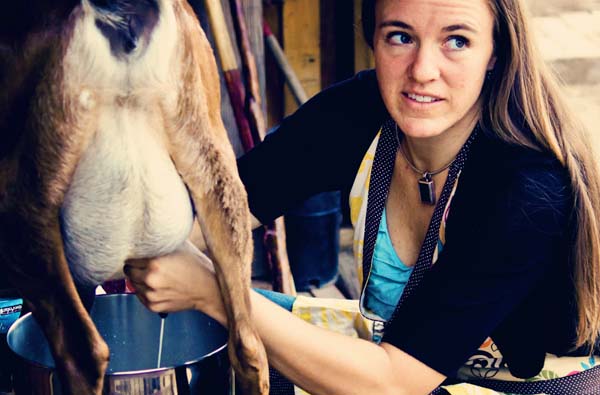
Lindsey (The Goat Cheese Lady) and her husband live a 10-minute drive away from me, where she spends her days taking care of her animals (goats, chickens and rabbits) and garden, and her weekends teaching locals how to make their own delicious cheese.
Much to my insistence surprise, Lindsey invited me and my mother (who served as the fab photographer of the day) over on a non-class day for a tour and mini-lesson, and she and her husband Herbert treated me to an udderly enlightening time.
Ah. I love these people.
I milked goats:

Then we gathered eggs, made kissy-faces at the bunnies, strolled around the garden picking gorgeous little nubbins of tomatoes, and then headed back into the house to learn how to make chevre, queso fresco, or queso blanco, depending on what you want to call it. (Chevre if it’s made with goat milk, which is either cultured or uncultured like the one we made today, queso fresco or blanco can be made with goat or cow milk. Really, they’re all nearly identical.)
Either way, it’s very similar to the goat cheese you’d buy in the store, only SO much better. Crumbly, moist, mild and perfect for seasoning just how you want it.
And I’m going to show you how WE made it; then you can do it yourself.
No really. You REALLY can. You don’t have to milk a goat or anything (unless you really want to).
How to Make Your Own “Fresh Cheese”
You know how most of the things I post (especially food things) are so easy even a slack-jawed newbie could do it? (By slack-jawed newbie, I mean me.)
This, my dears, is no exception. Please be advised, you need two ingredients to do this: Milk and vinegar.
The end.
Of course, you may want to season it with things like garlic or sun-dried tomatoes or even tender, cinnamon-covered cranberries.
But to make cheese happen, milk and vinegar is all you need. But the milk must NOT be ultra-pasteurized, nor can it be low or non-fat. You want whole, rich milk – and, of course, organic is the option to choose. BUT, even more than that, if you have raw milk (or raw goat milk) to use, that’s the best option ever.
And yes, you can use cow milk instead of goat. (Lindsey told me so … and I can’t wait to try it here at home.)
Here’s how you do it:
Step 1: Heat One Gallon of Milk
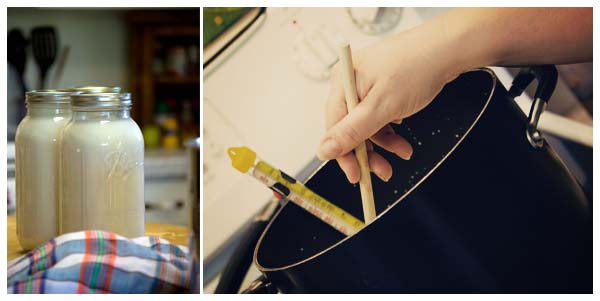
Pour two quarts one gallon (edit: oops!) of milk into a pot and heat on high until the temperature reaches 180 degrees. (Or, as instructed here, you could heat it on high just until boiling.)
Stir the whole time the milk is heating, and try not to let it scald. If, for some reason, it does scald, that’s okay. Just don’t scrape all that icky stuff up into the milk. Let it languish there on the bottom.
Step 2: Remove the milk from the heat and add in 1/2 c. vinegar (distilled white or apple cider)
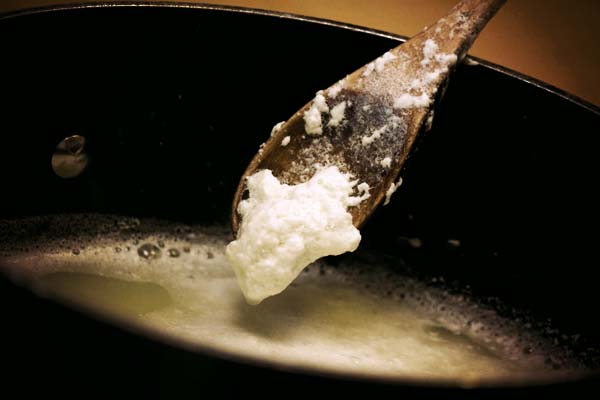
After removing your pot from the heat, pour in 1/2 c. vinegar (distilled white or apple cider) and stir. Nearly immediately, you’ll end up with separated curds and whey. This is where the fun begins. You can let this mixture sit for anywhere from 10 seconds to hours (depending on whether you’re ready to finish making your cheese or not.)
(And, if you want to get cultured with your chevre, you could pick up some chevre starter culture to turn your cheese into creamy goodness, rather than the rich, thick crumbles we’re making here. Making cultured chevre takes a day or two, while this cheese here is edible immediately.)
Step 3: Strain the Whey from the Curds
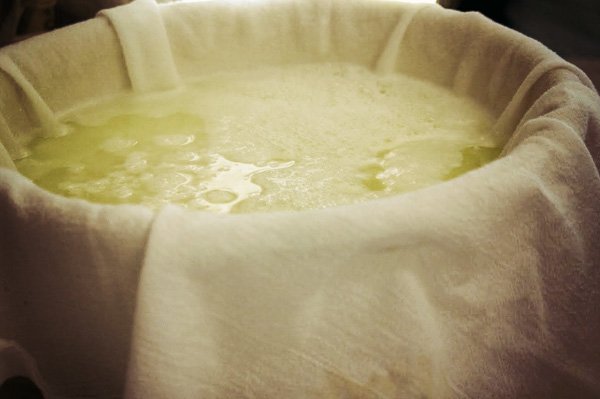
Drape a large cloth (double- or triple-ply cheesecloth, muslin, or even a strong (very clean) tea towel) in a large bowl and pour your entire mixture over the top.
Knot the towel on opposite corners, and then carefully remove the “bag of curds” and hang from your cabinet doors (or another fixture), letting the remaining whey drip from the curds into your whey bowl.
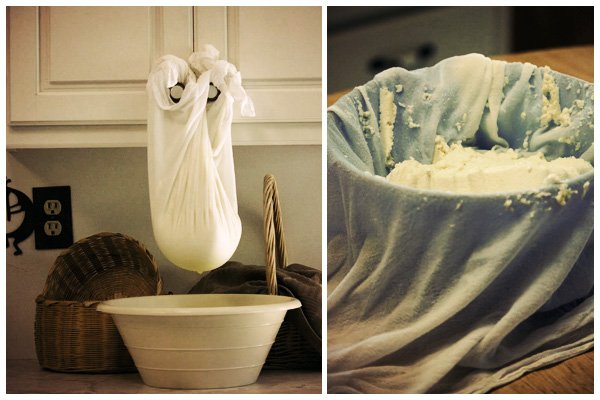
After the whey has stopped dripping from your curds, remove the towel, unknot it, and set the cheese into another large bowl. Scrape off any remaining cheese from the cloth.
Step 4: Enjoy Your Cheese. NOW.
At this point, you can add in 1/2 to 1-1/2 Tbsp salt (depending on how salty you like it), herbs, garlic, fruits, nuts, whatever tickles your fancy.
Just stir it in and mush it all around.
And then you have …
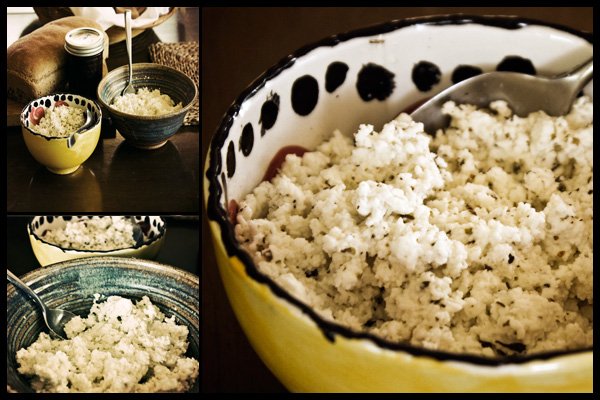
That’s it!
That’s all there is to it.
(I have to admit, I feel really, really slow for not knowing how easy this was all along. Never again will I buy a container of goat cheese.)
THANK YOU, Lindsey the Goat Cheese Lady, for a fantastic morning – and for teaching me how to be just a little more self-sufficient. (Also for the eggs, cheese, bread, laughter, and … being new friend. Sigh.)
Did I Mention, They Named a Chicken Crunchy Betty?
Yep.
Meet Crunchy Betty:

Lindsey’s husband insisted I pick a chicken to name Crunchy Betty. I agreed to it, as long as they promised not to eat it.
Herbert said, “If we do, we’ll invite you over for dinner.”
What happens when a Crunchy Betty eats a Crunchy Betty?
The end of the world due to a super-massive black hole?
All that’s left is a puff of feathers, floating in the nowhere …
PPS: Are you going to try this or what? (The cheese, not the black hole thing.)
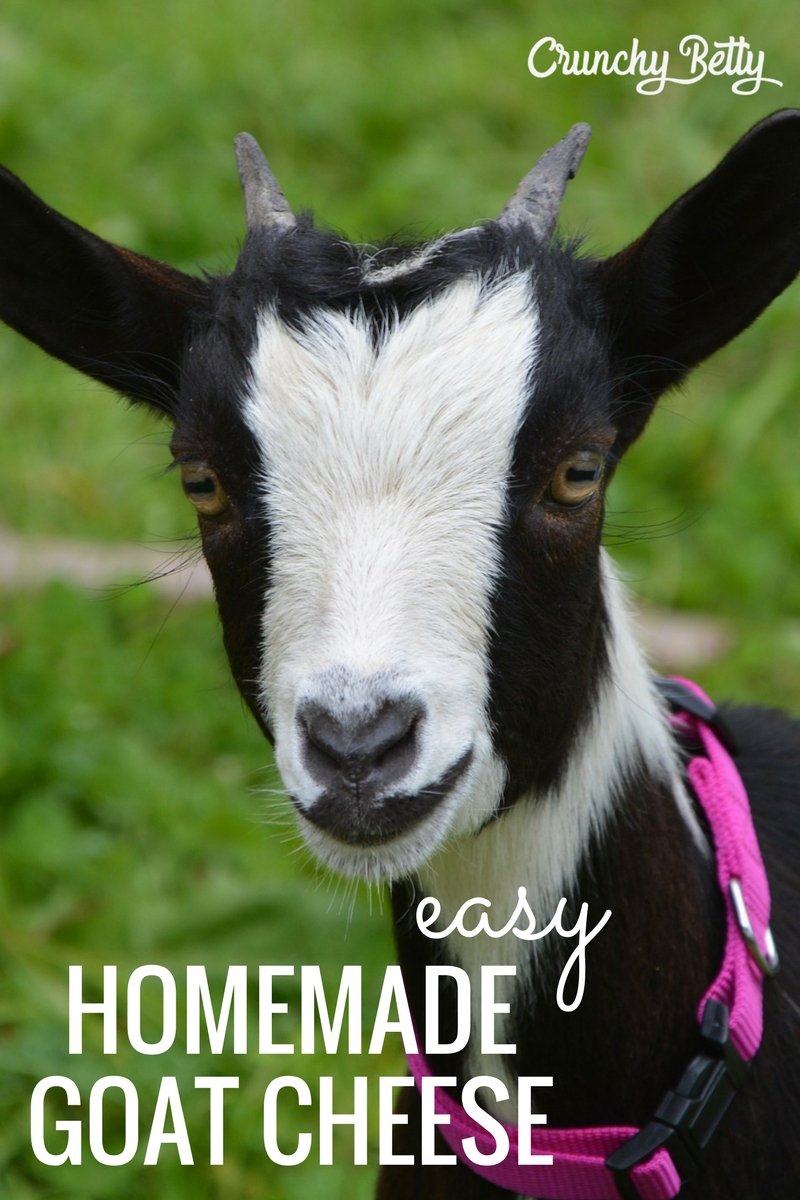

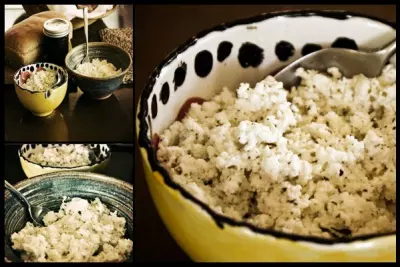
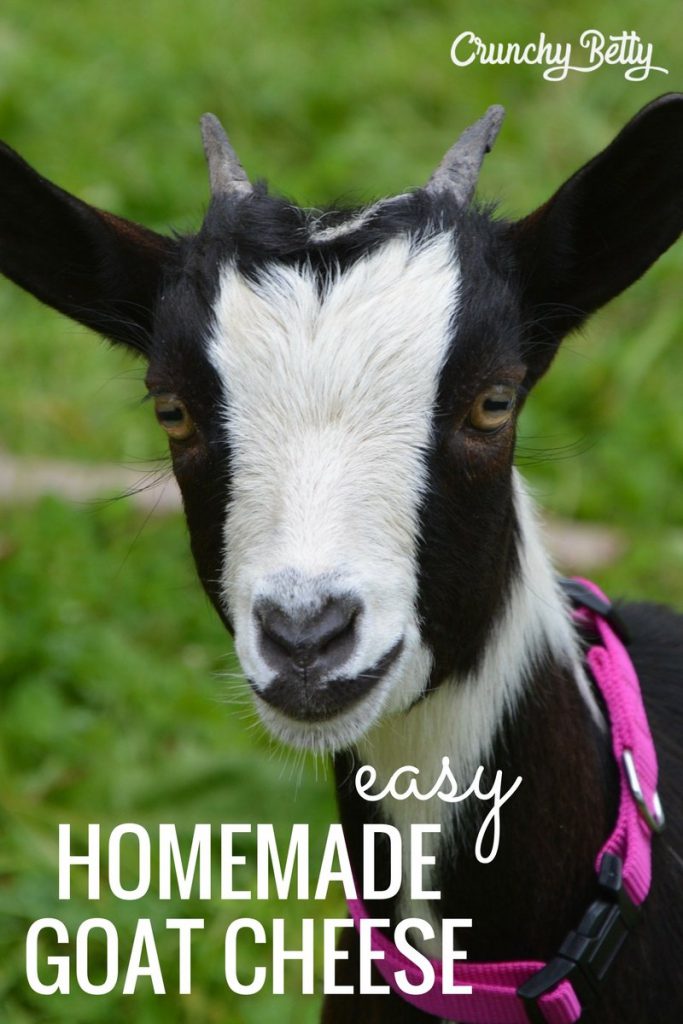
 Should We Give the FDA MORE Power? Safe Cosmetics Act 2011
Should We Give the FDA MORE Power? Safe Cosmetics Act 2011
And done! It’s as easy as you said…..I’m contemplating options for what to do with it now…..pupusas (never had them but they sound good)….ravioli….. I’m going to use the whey to make some grape nuts.
I’ve made this with farm fresh cow’s milk. I was absolutely lovely on slices of crusty bread. I must make it again, maybe tonight…
Betty, now you have to try yogurt! I’ve got a tutorial – let me know if you want the link. It’s so easy!
Hi, CB!
I just wanted to tell you how thankful I am that this site exists! This is the exact thing the world needs and I’m extremely impressed by how much work you’ve put into it.
I’m new here, so I’m starting at your first post and reading ALL the way through to catch up on all the great stuff I’ve missed.
If you ever need an assistant, I’d love to be that girl 🙂
Thank you so much!
Silly question – but how do you use goat cheese? What types of dishes can it be added to?
Great question!! I use goat cheese in salads, quesadillas, on bread, in sandwiches, crumbled onto soup, or just plain by the spoonfulls!!!
and DON’T throw away your remaining WHEY… let it sit in a cool place for 12 – 24 hours, heat slowly over medium heat, and voila! you have ricotta cheese. THEN use whatever whey is left to add umph and vitamins to soups, or feed it to your pet, or whatever. Just DON’T throw all that goodness away!
The whey from making mozzarella or hard cheeses is best for making ricotta, because those cheeses don’t contain vinegar. When I use vinegar in a recipe, it strips everything out of the milk, leaving only water and whey protein in the whey, but no fat or protein solids to be heated into ricotta. The mozzarella and hard cheese whey does though! So, that’s the best way to go!
A D…I’ve never done it by letting the whey sit for 12-24 hours…are you able to get ricotta out of your whey from vinager curded cheese?
My husband and I have done this before and it is wonderful! We used lemon juice, but it was so good! We’ve got to do this again! Thanks for the reminder. Looks like you had a fun day!
So cool! Does this method only work with goat’s milk or cow’s milk too?
Grace, You can do it with either kind of milk!
Wait–I have no access to raw dairy here. Can I do organic goat’s milk? You said NOT “ultra” pasteurized. Does that mean “regular” pasteurized is OK?
Yes! Regular pasteurized is OK…just watch out for the tiny print that might say “high heat pasteurized” or “UP” or “ultra pasteurized.” Have fun!!
I have made paneer this way too, except with lemon juice instead of vinegar. It’s super easy, and so yummy. Thank you for reminding me that I should make some again soon!
I love Paneer and never imagined being able to make it myself… recipe?
I know I’ve said it before but I love your site. Your enthusiasm is absolutely contagious… makes me want to try EVERYTHING. (I’m currently at the yucky end of week one of no ‘pooing, and day 2 of homemade deodorant–LOVE IT–I smell like orange frosted sugar cookies because I added Orange EO to mine.)
I am also curious about the amount of cheese this makes and how to store it. I am absolutely going to try this as it might be a really great cheese for someone like me whose mildly lactose intolerant! Now to find some raw goat milk… 🙂
Thank you for doing this–what a fun day! And your mom is an awesome photographer.
And now, a few practical questions.
1. What sort of pot? I don’t own any non-stick cookware so I’m looking at my stainless steel/copper bottomed pot or my cast iron Dutch oven (I’m guess that wouldn’t be a good choice!
2. How much cheese do you end up with? A cup? A pound? Guesstimate is fine.
3. Does it have to be refrigerated? If so, how soon?
4. How should it be stored?
5. So when are you going to have Mike Rowe from Dirty Jobs stop by and help you whip up all your crunchy cleaners and cosmetics? (Really, it would be a fun episode!)
Again, thanks so much for sharing.
Mike Rowe—-2 Funny! That would be one unforgetable episode. I say YES! What a way for CB to get the “word” out.
Nanc,
1. The best pot to use is stainless steel…so yours sounds great.
2. From a gallon of raw goat milk, you will get about 25 ounces of cheese. Probably less from grocery store whole milk, due to less fat content, but I’m not sure…haven’t tried it.
3. I should be eaten or refrigerated within about 8 hours of making.
4. I store mine in a closed container in the refrigerator.
Hve fun!!!
This is great! It’s very much like how I make yogurt, so I guess I have no excuse not to make this. The photo of it hooked on the cupboard knob stopped me in my tracks before I even read about it… my one hang-up (pardon the pun) when making yogurt is having a deep enough container for it to drain into. You’ve just solved that for me, thank you!
What kind of goats did you meet? We would totally have a goat if we had the space for it… they’re so funny and sweet. That chicken may be named Crunchy Betty, but Crunchy Betty is no chicken!
If possible, you can also tie your cloth around a wooden spoon or dowel and hang between two chairs to drain. Or use a laundry rack. (If you have animals, maybe not so much.) The cabinet is definitely a new one on me!
Thanks for the ideas Kate! I’ve done the “broomstick between two chairs” trick before when drying pasta. It’s a little awkward with my chairs, but it does work. I’m just so happy to have found a solution that keeps the bowls of draining yogurt/cheese up on the counter-top! 🙂
I love the stick between chairs idea! I’ve never tried that…or thought of that! I’m going to start making 5 gallon batches, so I’ll need the stick idea!
I’m so excited you did this. How cool! I love using goats milk because I’ve heard it’s a lot better for you than milk from a cow. I wonder what other things we can do with goats milk. Face masks? Soap?!
I can’t wait to see what Betty comes up with…if she doesn’t drink the milk and whey I sent home with her first! I use raw goat’s milk in her nutmeg and milk scrub, and I LOVE IT! I grind about 1/2 to 1 TBSP of fresh nutmeg and add enough milk to make a paste and rub it into my face and neck for a few minutes. It’s awesome!
I also make soap with it, which is wonderful for my excema prone hands. But, I’ve learned from Betty that since my soap contains coconut oil, I shouldn’t use it on my face due to pore clogging potential. I’m going to change the recipe in my next batch.
Goat’s milk is easier for a lot of people to digest, as it has shorter fatty acid chains than cow’s milk, so the gut doesn’t have to work as hard to digest it. Also, when any milk is raw (i.e. not pasteurized), it still contains all the enzymes necessary to digest the milk. So, if a person is sensitive to grocery store milk, they should try raw milk…they may find they have no problems with it!
Just curious Lindsey, have you had issues with pores while using the coconut oil soap? I don’t use soap on my face because I use OCM, but I’ve heard different things about whether coconut oil should be used on your face because it may clog pores. I’ve used it on my face and body without issue, and before OCM I was super acne prone.
Kylieonwheels, What is OCM? All I can come up with is Over the Counter Medicine. No, I wouldn’t say I’ve noticed the coconut oil in my soap has caused a problem, as it’s the best soap I’ve every used (used to buy Dove), but once I learned the coconut oil clogging possibility, I decided to stop using it on my face and use jojoba oil and milk/nutmeg. I still need to try more of Crunchy Betty’s ideas though!
Ahhh, you’ve got some research ahead of you 🙂 Oil Cleansing Method. It changed my life. Once acne-ridden, now glowy-healthy-lovely-smoochable-happy 🙂
Until it ran out, I was using coconut oil on my face with no problems. It was my moisturer following cleasning with OCM. (So love it! It leaves my skin clean but still soft!)
I also used as a treatement on my hair and a shaving cream.
Both my skin and hair are dry and I’m not prone to breakouts so I don’t know how coconut oil would behave on blemish prone.
This is definitely on my list of things to do in October—probably this weekend. What a great way to spend a day and with your mom too.
I believe that a simple and unassuming manner of life is best for everyone, best both for the body and the mind. ~Albert Einstein
Looks like a FUN day! 🙂
Don’t forget how awesome the whey is — the leftover stuff. You can use it to do all kinds of awesome stuff in the kitchen or you can just mix it into smoothies because it’s super good for you (and you can’t taste it in a smoothie).
Whey from this particular cheesemaking process makes me uber-happy because (a) you get CHEESE and (b) you get a boatload of whey — more that I get when I strain yogurt, for example. Double the pleasure.
I cannot tell you how much it amuses me that you have a namesake chicken. I hope “Crunchy Betty” spawns a heritage breed.
Yes! The whey is fantastically nutritious. I use it in place of water in my bread recipes, but it has all sorts of applications. Smoothies are a great idea!
It’s packed with protein and really good in pancakes and waffles, too 🙂
Stephanie and Lex, I use it to soak beans and rice in, to impart more protein and to get a nuttier flavor. I haven’t been able to bring myself to drink it, because this vinegar whey is too acidic for me. I haven’t tried it in pancakes or waffles either…that sounds good! I have used it in place of water in my bread recipe, however the bread was VERY dense and didn’t rise well at all…whereas when I use water, it is light and rises well. Any suggestions?
oh my god, i looooove queso fresco!!!! i seriously cannot wait to get home from work to try this! yipee! thanks, crunchy betty 🙂
i made it last night….ridiculously easy and soooooo good! i made it with whole milk and only a half batch since i only had a half gallon of whole milk. from whole food. their 365 brand and it worked splendidly. i would probably add more salt next time (which is this weekend!) for something more like cotija since bf and i are making tamales! so yay! i was eating it with a spoon by itself this morning because its just that delicious 🙂 thanks, CB and the goat cheese lady!
Oh, Betty, that was so fun to see the pictures and relive our fun yesterday! It was so great to meet you and your mom, I feel fortunate to have both of you as new friends too. I’ll invite you over for more cheesemaking or talking or milking or coffee or goat milk and whey cosmetic making, or whatever…just more time to hang out together! I had a ball! And, I’m thinking of asking your mom to be my official The Goat Cheese Lady photographer…?????
Just a couple additions to your post, which was fantastic! 1. It’s actually 2 half gallon jars heated up to 180 degrees instead of 2 quarts. So, for each half gallon of milk, stir in 1/4 cup vinegar. 2. I use flour sack cloth to drain the curds (so far I’ve only found flour sack cloth for sale in the dish towel section of Walmart).
Thanks again for a GREAT day yesterday!!!
Lindsey – The Goat Cheese Lady
Yay! Thank you again for having me. We’ll talk soon (writing an email to tell you about my phone … how silly is that?)!
Honestly, when I was writing this yesterday (TOTALLY exhausted), I started wondering how many things I remembered incorrectly. I’m impressed that it was only the half-gallon vs. quarts. Sheeh! I’m going to edit that to be correct now.
And I cannot tell you how much I wish, right now, upon waking up, I was headed out to gather eggs and get head-butted by goats. Your life is so awesome.
Talk soon!
This is actually a paneer recipe 🙂
If you’re not familiar with Indian food, paneer is the Indian go-to cheese. The only difference is that it’s made with cow’s milk. Also, while some recipes call for quite a bit of vinegar to separate the curds and whey, you can use as little as one or two tablespoons of lemon juice instead, which is the most common way to make paneer. If you want a firmer texture than the crumbles (though the crumbles are delicious as they are), simply place a cookie sheet on top of the curds (plain or spiced/herbed) in cheesecloth and put a weight on top. I usually just put a large can or jar of something on top and let it set for a couple hours, put it in the fridge, then voila! It can be sliced and added to meals. Super easy.
Lex, It’s good to have confirmation…in my classes I tell people that if they make this cheese with cow’s milk, *i think* it would be called “Paneer”…however I haven’t ever made it with cow’s milk myself, so haven’t looked into it much. I have used lemon juice for curding…but long ago. I’ll have to try it again, in the quantity you suggest.
It’s amazing that you can make (nearly) every kind of cheese with cow, sheep or goat milk and with whatever milk you use….you just give it a diffent name…and it acquires a slightly different taste. But, the process can be the same.
Another thing I mention in my classes is that the “chevre” recipe I teach actually has a lot of different names. I call it “chevre” (because chevre is the most well known goat cheese and chevre means goat), but others call it queso blanco, farmer’s cheese, queso fresco, sock cheese (kind of leaves an interesting picture in the mind, huh?), vinegar cheese. But, traditional chevre is actually a 24 hour ripening, curding, draining process that I haven’t figured out how to fit into a 4 hour class! =)
Thanks so much for sharing your knowledge of paneer and how to make it. I haven’t ever tried the cookie sheet idea…I like that!
Lindsey – The Goat Cheese Lady
Lindsey,
I’ve never tried it with goat milk before, but I absolutely love goat milk (grew up with three goats as well as chickens and a garden back home in the Seattle suburbs).
Take a look at this link (Manjula has saved me soo many times! Indian fiance can thank her for 90% of my desi cooking skills even though she’s Jain and cooks mostly Gujarati food): http://www.manjulaskitchen.com/2008/05/24/how-to-make-paneer/ She also has other videos including different ways to make the cheese, and this one in particular is delicious http://www.manjulaskitchen.com/2010/10/20/achari-paneer/
In her recipes, she uses a bit more lemon juice than I usually do, but that is because she washes it out afterward. I don’t wash my paneer and just prefer to use less lemon juice. The trick is to keep the milk on the stove just before boiling for another 10 or so minutes after you add the lemon juice and you’ll see the curds and whey separate, just more slowly.
Great! I’ll check it out!
Non stop giggles. That was me reading this post. 😀 We have a long weekend coming here in Canberra. I think I shall try this.